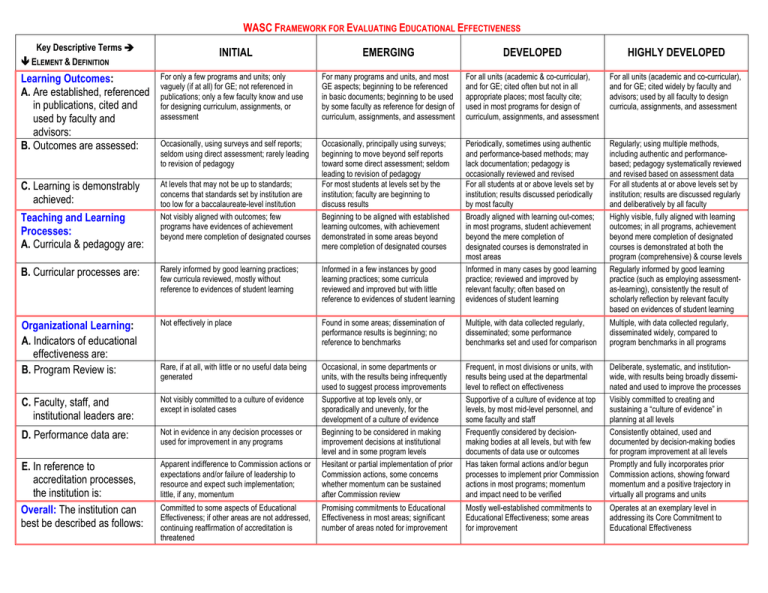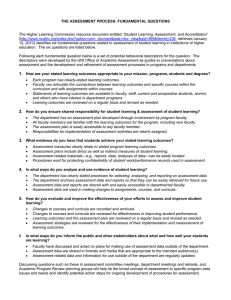INITIAL EMERGING DEVELOPED HIGHLY DEVELOPED Learning
advertisement

WASC FRAMEWORK FOR EVALUATING EDUCATIONAL EFFECTIVENESS Key Descriptive Terms Î Ð ELEMENT & DEFINITION INITIAL EMERGING DEVELOPED HIGHLY DEVELOPED Learning Outcomes: A. Are established, referenced in publications, cited and used by faculty and advisors: B. Outcomes are assessed: For only a few programs and units; only vaguely (if at all) for GE; not referenced in publications; only a few faculty know and use for designing curriculum, assignments, or assessment For many programs and units, and most GE aspects; beginning to be referenced in basic documents; beginning to be used by some faculty as reference for design of curriculum, assignments, and assessment For all units (academic & co-curricular), and for GE; cited often but not in all appropriate places; most faculty cite; used in most programs for design of curriculum, assignments, and assessment For all units (academic and co-curricular), and for GE; cited widely by faculty and advisors; used by all faculty to design curricula, assignments, and assessment Occasionally, using surveys and self reports; seldom using direct assessment; rarely leading to revision of pedagogy C. Learning is demonstrably achieved: At levels that may not be up to standards; concerns that standards set by institution are too low for a baccalaureate-level institution Not visibly aligned with outcomes; few programs have evidences of achievement beyond mere completion of designated courses Occasionally, principally using surveys; beginning to move beyond self reports toward some direct assessment; seldom leading to revision of pedagogy For most students at levels set by the institution; faculty are beginning to discuss results Beginning to be aligned with established learning outcomes, with achievement demonstrated in some areas beyond mere completion of designated courses Regularly; using multiple methods, including authentic and performancebased; pedagogy systematically reviewed and revised based on assessment data For all students at or above levels set by institution; results are discussed regularly and deliberatively by all faculty Highly visible, fully aligned with learning outcomes; in all programs, achievement beyond mere completion of designated courses is demonstrated at both the program (comprehensive) & course levels Regularly informed by good learning practice (such as employing assessmentas-learning), consistently the result of scholarly reflection by relevant faculty based on evidences of student learning B. Curricular processes are: Rarely informed by good learning practices; few curricula reviewed, mostly without reference to evidences of student learning Informed in a few instances by good learning practices; some curricula reviewed and improved but with little reference to evidences of student learning Periodically, sometimes using authentic and performance-based methods; may lack documentation; pedagogy is occasionally reviewed and revised For all students at or above levels set by institution; results discussed periodically by most faculty Broadly aligned with learning out-comes; in most programs, student achievement beyond the mere completion of designated courses is demonstrated in most areas Informed in many cases by good learning practice; reviewed and improved by relevant faculty; often based on evidences of student learning Organizational Learning: A. Indicators of educational effectiveness are: B. Program Review is: Not effectively in place Found in some areas; dissemination of performance results is beginning; no reference to benchmarks Multiple, with data collected regularly, disseminated; some performance benchmarks set and used for comparison Multiple, with data collected regularly, disseminated widely, compared to program benchmarks in all programs Rare, if at all, with little or no useful data being generated C. Faculty, staff, and institutional leaders are: Not visibly committed to a culture of evidence except in isolated cases D. Performance data are: Not in evidence in any decision processes or used for improvement in any programs E. In reference to accreditation processes, the institution is: Overall: The institution can best be described as follows: Apparent indifference to Commission actions or expectations and/or failure of leadership to resource and expect such implementation; little, if any, momentum Occasional, in some departments or units, with the results being infrequently used to suggest process improvements Supportive at top levels only, or sporadically and unevenly, for the development of a culture of evidence Beginning to be considered in making improvement decisions at institutional level and in some program levels Hesitant or partial implementation of prior Commission actions, some concerns whether momentum can be sustained after Commission review Frequent, in most divisions or units, with results being used at the departmental level to reflect on effectiveness Supportive of a culture of evidence at top levels, by most mid-level personnel, and some faculty and staff Frequently considered by decisionmaking bodies at all levels, but with few documents of data use or outcomes Has taken formal actions and/or begun processes to implement prior Commission actions in most programs; momentum and impact need to be verified Deliberate, systematic, and institutionwide, with results being broadly disseminated and used to improve the processes Visibly committed to creating and sustaining a “culture of evidence” in planning at all levels Consistently obtained, used and documented by decision-making bodies for program improvement at all levels Promptly and fully incorporates prior Commission actions, showing forward momentum and a positive trajectory in virtually all programs and units Promising commitments to Educational Effectiveness in most areas; significant number of areas noted for improvement Mostly well-established commitments to Educational Effectiveness; some areas for improvement Operates at an exemplary level in addressing its Core Commitment to Educational Effectiveness Teaching and Learning Processes: A. Curricula & pedagogy are: Committed to some aspects of Educational Effectiveness; if other areas are not addressed, continuing reaffirmation of accreditation is threatened
